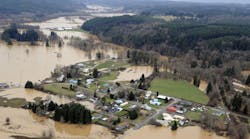Charles River Earns 'B+' on Annual Water Quality Checkup
For the third consecutive year, the lower Charles River in Massachusetts has attained its highest-ever grade from the U.S. Environmental Protection Agency (EPA), a B+, reflecting that efforts by government and local groups to restore the river to ecological health by reducing bacteria in the river are on track. Data showed strong progress toward the goal of making the Charles safe for swimming all of the time.
The grade is based on measurements of bacteria levels and the number of days the river met boating and swimming standards during the previous calendar year. For 2006, the Charles met boating standards 90% of the time and swimming standards 62% of the time, according to data collected by the Charles River Watershed Association (CRWA) between Watertown Dam and Boston Harbor.
EPA’s focus on the number of days that the lower Charles met swimming standards illustrates that 2006 was one of the best years for meeting swimming standards since EPA began the Clean Charles Initiative, and the 62% figure represents a significant achievement given the unusually high amount runoff due to rainfall during the spring. For more than a decade, the Charles River Initiative has featured coordinated efforts between EPA, state and local governments, private organizations and environmental advocates, working together to improve the health of the lower Charles River.
Under a settlement between EPA and the Massachusetts Water Resources Authority (MWRA) last year, sewage discharges to the river declined in 2006, and are expected to continue declining for the next eight years. By the time this effort is completed in 2013, MWRA will have reduced flows from sewer relief pipes by an impressive 99.5%. Furthermore, the municipalities of the lower Charles continued to chip away at sewage flows from storm water pipes, eliminating 7,500 gal per day during 2006. This is in addition to the more than 1 million gal per day eliminated from storm drain systems since EPA began the Charles cleanup effort a decade ago.
The Charles has improved dramatically from the launch of EPA’s Charles River Initiative in 1995, when the river received a D for meeting boating standards only 39% of the time and swimming standards just 19% of the time. The improved water quality in the Charles means that efforts by other local groups to bring swimming back to the river are more likely to succeed in the future.
Even as bacteria levels, the basis for the annual grade, have been on the decline now for roughly a decade, another potentially serious problem affecting the Charles River has gotten progressively worse in recent years—elevated levels of nutrients entering the river in storm water runoff.
“We’ve made tremendous progress eliminating sewage from the river. That’s just not good enough, however. We have to fix the toxic algae blooms, and begin to figure out how to fix the sediments. With this partnership we’ve forged with EPA and DEP, I’m convinced we’ll get there,” said Bob Zimmerman, executive director of the CRWA.
Last summer, algae, which are waterborne plant-like organisms that can create a blue-green coloration and can have toxic effects, bloomed with great frequency and intensity. The proliferation of algae is caused in part by nutrients such as phosphorus entering the river and providing food for them. While EPA’s ongoing work directed at bacterial sources will also help reduce nutrients and algae blooms, the agency has directed new energy toward controlling the amount and quality of storm water, which is a large source of nutrients. Rain and snow melt empties into the river as either sheet flow or through storm drains that flow from streets and other impervious areas.
EPA has issued storm water permits to municipalities that require them to operate and maintain their storm drain systems, regulate construction sites, educate citizens about storm water and conduct other activities to minimize storm water’s harmful effects. EPA will be reissuing and tightening these permits next year, which will help reduce nutrients and other pollutants. In addition, EPA will be examining other major sources of nutrients to the Charles and requiring them to take the necessary steps to reduce the loading.
Recently, EPA and Massachusetts proposed a “total maximum daily load,” resulting from an assessment examining the impact of nutrients on the lower Charles. This assessment also determines what reduction in nutrients will be necessary to meet water quality standards on the river. The results of the assessment indicate that nutrient loads from storm water must be reduced by 50 or 60% to meet water quality standards.
“This won’t be an easy problem to solve, but we will be looking to all sources of elevated nutrients in storm water runoff to see that the necessary reductions will occur,” said Robert W. Varney, regional administrator for EPA’s New England office.
Source: EPA


